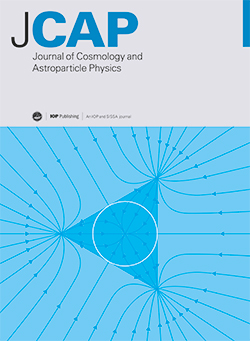滑向暗物质:仅利用星系的局部圆周速度确定局部暗物质密度和速度分布
IF 5.3
2区 物理与天体物理
Q1 ASTRONOMY & ASTROPHYSICS
Journal of Cosmology and Astroparticle Physics
Pub Date : 2024-08-12
DOI:10.1088/1475-7516/2024/08/022
引用次数: 0
摘要
我们利用 FIRE-2 对银河系大小的盘状星系进行变焦模拟,推导出在太阳位置观测到的银河系圆周速度 vc 与直接探测实验相关的暗物质特性(暗物质密度、暗物质速度色散和太阳位置附近暗物质粒子的速度分布)之间的易用关系。我们发现,当地的暗物质密度和三维速度弥散都与 vc 遵循紧密的幂律关系。利用这一关系和太阳半径处观测到的银河圆周速度,我们推断太阳附近的本地暗物质密度和速度色散分别为ρ = 0.42±0.06 GeV cm-3和σ3D = 280+19-18 km s-1。我们还发现,暗物质粒子速度的分布可以用一个修正的麦克斯韦方程来很好地描述,它有两个形状参数,都与观测到的vc相关。我们用修正的麦克斯韦公式来预测太阳附近暗物质的速度分布,发现它在 257 km s-1 的最可能速度处达到峰值,并在 470 km s-1 以上开始急剧截断。这个峰值速度比标准光环模型的预期速度要高一些,而且截断的速度远远低于形式上的无穷逃逸速度,超高速粒子的数量也比标准光环模型假设的要少。本文章由计算机程序翻译,如有差异,请以英文原文为准。
Sliding into DM: determining the local dark matter density and speed distribution using only the local circular speed of the galaxy
We use FIRE-2 zoom simulations of Milky Way size disk galaxies to derive easy-to-use relationships between the observed circular speed of the Galaxy at the Solar location, vc, and dark matter properties of relevance for direct detection experiments: the dark matter density, the dark matter velocity dispersion, and the speed distribution of dark matter particles near the Solar location. We find that both the local dark matter density and 3D velocity dispersion follow tight power laws with vc. Using this relation together with the observed circular speed of the Milky Way at the Solar radius, we infer the local dark matter density and velocity dispersion near the Sun to be ρ = 0.42±0.06 GeV cm-3 and σ3D = 280+19-18 km s-1. We also find that the distribution of dark matter particle speeds is well-described by a modified Maxwellian with two shape parameters, both of which correlate with the observed vc. We use that modified Maxwellian to predict the speed distribution of dark matter near the Sun and find that it peaks at a most probable speed of 257 km s-1 and begins to truncate sharply above 470 km s-1. This peak speed is somewhat higher than expected from the standard halo model, and the truncation occurs well below the formal escape speed to infinity, with fewer very-high-speed particles than assumed in the standard halo model.
求助全文
通过发布文献求助,成功后即可免费获取论文全文。
去求助
来源期刊

Journal of Cosmology and Astroparticle Physics
地学天文-天文与天体物理
CiteScore
10.20
自引率
23.40%
发文量
632
审稿时长
1 months
期刊介绍:
Journal of Cosmology and Astroparticle Physics (JCAP) encompasses theoretical, observational and experimental areas as well as computation and simulation. The journal covers the latest developments in the theory of all fundamental interactions and their cosmological implications (e.g. M-theory and cosmology, brane cosmology). JCAP''s coverage also includes topics such as formation, dynamics and clustering of galaxies, pre-galactic star formation, x-ray astronomy, radio astronomy, gravitational lensing, active galactic nuclei, intergalactic and interstellar matter.
 求助内容:
求助内容: 应助结果提醒方式:
应助结果提醒方式:


